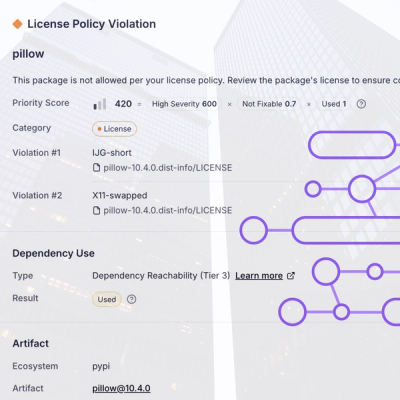
Research
/Security News
Critical Vulnerability in NestJS Devtools: Localhost RCE via Sandbox Escape
A flawed sandbox in @nestjs/devtools-integration lets attackers run code on your machine via CSRF, leading to full Remote Code Execution (RCE).
Collection of misc DOM manipulation functions not nativly provided by the DOM api
Collection of misc DOM manipulation functions. These are helper functions which are not nativly provided by the DOM api's.
$ npm install dom-util
$ npm test
Tests are written in mocha and run in node.js with the help of jsdom.
Example on converting all values on an attribute to an Array.
HTML:
<div id="foo" class="foo bar"></div>
JS:
var dom = require('dom-util');
var element = document.getElementById('foo');
var attributes = dom.attributeToArray(element, 'class');
console.log(attributes); // returns ['foo', 'bar']
Some functions can be chained. Iow; this is possible:
dom.addFirstChildElement(root, newEl)
.removeLastChildElement(root);
The following methods are available:
Walk the DOM downwards from a given 'node' and executes a
callback on each node.
The callback must return true for the walking to continue
through the DOM. The walk is terminated by letting the
callback return false.
The current node which the callback is operating on is
available as this in the callback. The first variable to
the callback is the depth of the node in the DOM tree.
HTML:
<section>
<div id="bar">
<p></p>
<p>
<span></span>
</p>
</div>
</section>
JS:
var dom = require('dom-util');
var element = document.getElementById('bar');
dom.walkDown(element, function(depth){
if (this.nodeName === 'SPAN') {
console.log('Found a <span> at level: ' + depth);
return false;
} else {
return true;
}
});
Walk the DOM upwards from a given 'node' and executes a
callback on each node.
The callback must return true for the walking to continue
through the DOM. The walk is terminated by letting the
callback return false.
The current node which the callback is operating on is
available as this in the callback.
HTML:
<section>
<div>
<p></p>
<p>
<span id="bar"></span>
</p>
</div>
</section>
JS:
var dom = require('dom-util');
var element = document.getElementById('bar');
dom.walkUp(element, function(){
if (this.nodeName === 'DIV') {
console.log('Found a <div>');
return false;
} else {
return true;
}
});
Parses the values of a attribute on a DOM element to a Array.
HTML:
<div id="foo" class="foo bar"></div>
JS:
var dom = require('dom-util');
var element = document.getElementById('foo');
var attributes = dom.attributeToArray(element, 'class');
console.log(attributes); // returns ['foo', 'bar']
Removes all child elements of a DOM node.
HTML before:
<div id="foo">
<p>foo</p>
<p>bar</p>
</div>
JS:
var dom = require('dom-util');
var element = document.getElementById('foo');
dom.removeChildElements(element);
HTML after:
<div id="foo"></div>
Function is chainable.
Appends a Array of elements as children to a root element.
HTML before:
<ul id="foo"></ul>
JS:
var dom = require('dom-util');
var root = document.getElementById('foo');
var children = [];
children.push(document.createElement('li'));
children.push(document.createElement('li'));
dom.appendMultipleChildElements(root, children);
HTML after:
<ul id="foo">
<li></li>
<li></li>
</ul>
Function is chainable.
Appends an element as the first child to a root element.
HTML before:
<ul id="foo">
<li>a</li>
<li>b</li>
</ul>
JS:
var dom = require('dom-util');
var root = document.getElementById('foo');
var element = document.createElement('li');
element.innerText = 'x';
dom.addFirstChildElement(root, element);
HTML after:
<ul id="foo">
<li>x</li>
<li>a</li>
<li>b</li>
</ul>
Function is chainable.
Removes the last child element from a root element.
HTML before:
<ul id="foo">
<li>a</li>
<li>b</li>
<li>c</li>
</ul>
JS:
var dom = require('dom-util');
var root = document.getElementById('foo');
dom.removeLastChildElement(root);
HTML after:
<ul id="foo">
<li>a</li>
<li>b</li>
</ul>
Function is chainable.
Appends an element as a sibling above an element.
HTML before:
<div id="foo"></div>
JS:
var dom = require('dom-util');
var root = document.getElementById('foo');
var element = document.createElement('p');
dom.addSiblingAboveElement(root, element);
HTML after:
<p></p>
<div id="foo"></div>
Function is chainable.
Appends an element as a sibling below an element.
HTML before:
<div id="foo"></div>
JS:
var dom = require('dom-util');
var root = document.getElementById('foo');
var element = document.createElement('p');
dom.addSiblingBelowElement(root, element);
HTML after:
<div id="foo"></div>
<p></p>
Function is chainable.
Replace an element (and all its children) with a new element and returns the new element.
HTML before:
<div id="foo">
<p></p>
</div>
JS:
var dom = require('dom-util');
var existing = document.getElementById('foo');
var element = document.createElement('section');
dom.replaceElement(existing, element);
HTML after:
<section></section>
Remove a given element (and all its children).
HTML before:
<div>
<p id="foo"></p>
</div>
JS:
var dom = require('dom-util');
var element = document.getElementById('foo');
dom.removeElement(element);
HTML after:
<div></div>
Function is chainable.
Browser and node.js with jsdom.
The MIT License (MIT)
Copyright (c) 2014 - Trygve Lie - post@trygve-lie.com
Permission is hereby granted, free of charge, to any person obtaining a copy of this software and associated documentation files (the "Software"), to deal in the Software without restriction, including without limitation the rights to use, copy, modify, merge, publish, distribute, sublicense, and/or sell copies of the Software, and to permit persons to whom the Software is furnished to do so, subject to the following conditions:
The above copyright notice and this permission notice shall be included in all copies or substantial portions of the Software.
THE SOFTWARE IS PROVIDED "AS IS", WITHOUT WARRANTY OF ANY KIND, EXPRESS OR IMPLIED, INCLUDING BUT NOT LIMITED TO THE WARRANTIES OF MERCHANTABILITY, FITNESS FOR A PARTICULAR PURPOSE AND NONINFRINGEMENT. IN NO EVENT SHALL THE AUTHORS OR COPYRIGHT HOLDERS BE LIABLE FOR ANY CLAIM, DAMAGES OR OTHER LIABILITY, WHETHER IN AN ACTION OF CONTRACT, TORT OR OTHERWISE, ARISING FROM, OUT OF OR IN CONNECTION WITH THE SOFTWARE OR THE USE OR OTHER DEALINGS IN THE SOFTWARE.
FAQs
Collection of misc DOM manipulation functions not nativly provided by the DOM api
The npm package dom-util receives a total of 1 weekly downloads. As such, dom-util popularity was classified as not popular.
We found that dom-util demonstrated a not healthy version release cadence and project activity because the last version was released a year ago. It has 1 open source maintainer collaborating on the project.
Did you know?

Socket for GitHub automatically highlights issues in each pull request and monitors the health of all your open source dependencies. Discover the contents of your packages and block harmful activity before you install or update your dependencies.

Research
/Security News
A flawed sandbox in @nestjs/devtools-integration lets attackers run code on your machine via CSRF, leading to full Remote Code Execution (RCE).

Product
Customize license detection with Socket’s new license overlays: gain control, reduce noise, and handle edge cases with precision.

Product
Socket now supports Rust and Cargo, offering package search for all users and experimental SBOM generation for enterprise projects.